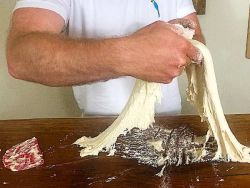
What Happens If You Put Too Much Yeast In Bread?

If you’re in the process of making bread and realise you have weighed out the yeast incorrectly, you’ll want to know what happens if there is too much yeast in bread? Is this you? If so, I’ll give you some quick answers to what happens and also some guidance, so you know what to do if you add too much yeast to bread dough.
What does yeast do to the bread?
Yeast is found in sourdough starters or baker’s yeast and has a few core roles to play in bread making. It reacts with the starches that are presented by the flour alongside other acid bacteria to create:
- Carbon dioxide
- Ethanol
- Lactic acid
- Organic acids
We largely associate yeast with creating carbon dioxide gas. This is what gets locked in the bread crumb structure to make the bread rise. Yet, the formation of ethanol, lactic acid and organic acids mature the dough and are just as vital to the dough-production process.
How does dough maturation work?
The gluten strands formed from hydrated flour are not strong enough to retain gas on their own. To support the structure of the dough, the yeast converts some starch into natural dough conditioners.
The development of ethanol, lactic acid, organic acid and cereal enzymes supports the gluten’s ability to transform flour, water, salt and yeast into bread. The conditioners support the dough’s gas retaining properties, the elasticity and extensibility of the dough, as well as the keeping quality, aroma and flavour of the bread. A well-fermented dough that has been made over a long period of time will be matured so that it contains a high amount of natural dough conditioners
What happens if you use too much yeast?
When too much yeast is added to the dough, the production of gas and ethanol increases rapidly to create a gassy dough that’s hard to work with! Due to the high gas activity, we can be forced to reduce the mixing time and/or get the loaves baked quickly before they over-proof. Dough that has a rushed fermentation period does not mature fully, leading to several quality issues once baked.
What happens to bread when too much yeast is added?
When proofing is rushed, the following faults can occur in the bread:
- Irregular holes through the bread crumb
- Ripped or ruptured crust
- Pale coloured bread
- Bread collapses when cutting or in the oven
- The taste and smell of bread flavours will decrease
- The bread smells and tastes of yeast
- The bread smells and tastes of alcohol
- Massive oven spring which results in the bread getting stuck in the oven
- The dough gets overly gassy so kneading time is reduced which lowers the quality of the bread
How much yeast is too much?
Most standard bread recipes use 1.5-2.2% yeast in the recipe with the most common being 2% for everyday bread. The percentage used for the recipe is based on the baker’s percentage for the bread made. This is where the percentage of each ingredient is derived from the total amount of flour used in the recipe.
If the percentage of yeast used is above 2.2% of the flour, the bread will taste and smell of yeast and is likely to suffer from the other common issues shown above. This is a trade-off when making sweet doughs as more yeast is required to compensate for the sugar interfering with the action of the yeast and slowing the rise.
Fresh, active dried and instant yeast conversion
The standard 2% yeast to flour ratio used in bread recipes is based on using fresh yeast. If using instant yeast or active dried yeast we need to convert the recipe to determine how much to use. We can convert roughly by halving the fresh yeast to get the value for active dried yeast or dividing the fresh yeast value by 3 to get the measurement for instant yeast. For accurate conversions, use these percentages to convert fresh yeast to active dried or instant yeast:
Where fresh yeast is 100%
Active dried yeast is 42%
Instant yeast is 33%
What to do if you add too much yeast to bread
The best thing to do if you have added too much yeast to the bread is to lower the temperature of the dough for bulk fermentation. Cool temperatures slow down the production of gas whilst still allowing the dough to continue maturing. If this can’t be done, there are a few other tips for working with over-yeasted dough:
- Midway through mixing, place the dough in the fridge to cool for ten minutes before mixing again
- Prepare for a big oven spring by under proofing the bread slightly
- Increase the salt to 2.2% of the flour used in the recipe. Salt helps to control the yeast.
- Trade white flour for whole-grain flour if possible, it will slow down the rate that the starch breaks down into sugars
- Don’t cut the bread before baking if it has had a quick rise
- Place in the fridge and use as a pâte fermentée in the following day’s dough
The breads smell & taste changes when too much yeast is added
If we make changes to control the yeast, such as cooling the dough down, there is one issue that cannot be reversed. If the yeast is added at levels higher than 2.5% the bread will smell and taste less like bread, and more like yeast. There is no way to reverse this.
Ending thoughts on using too much yeast
It’s a pain when you realise you have added too much yeast. The best thing we can do is to cool it down as soon as possible. I have found that I have to write out my recipes before I start baking, otherwise, accidents happen regularly! What have you learned from this article? Is there anything you are going to do differently in the future? Let me know in the comments, and for more troubleshooting tips check out my how to improve bread homepage.
If you’ve enjoyed this article and wish to treat me to a coffee, you can by following the link below – Thanks x

Hi, I’m Gareth Busby, a baking coach, senior baker and bread-baking fanatic! My aim is to use science, techniques and 15 years of baking experience to make you a better baker.
Table of Contents
- What does yeast do to the bread?
- How does dough maturation work?
- What happens if you use too much yeast?
- What happens to bread when too much yeast is added?
- How much yeast is too much?
- Fresh, active dried and instant yeast conversion
- What to do if you add too much yeast to bread
- Ending thoughts on using too much yeast
Related Recipes
Related Articles
Latest Articles
Baking Categories
Disclaimer
Address
53 Greystone Avenue
Worthing
West Sussex
BN13 1LR
UK







